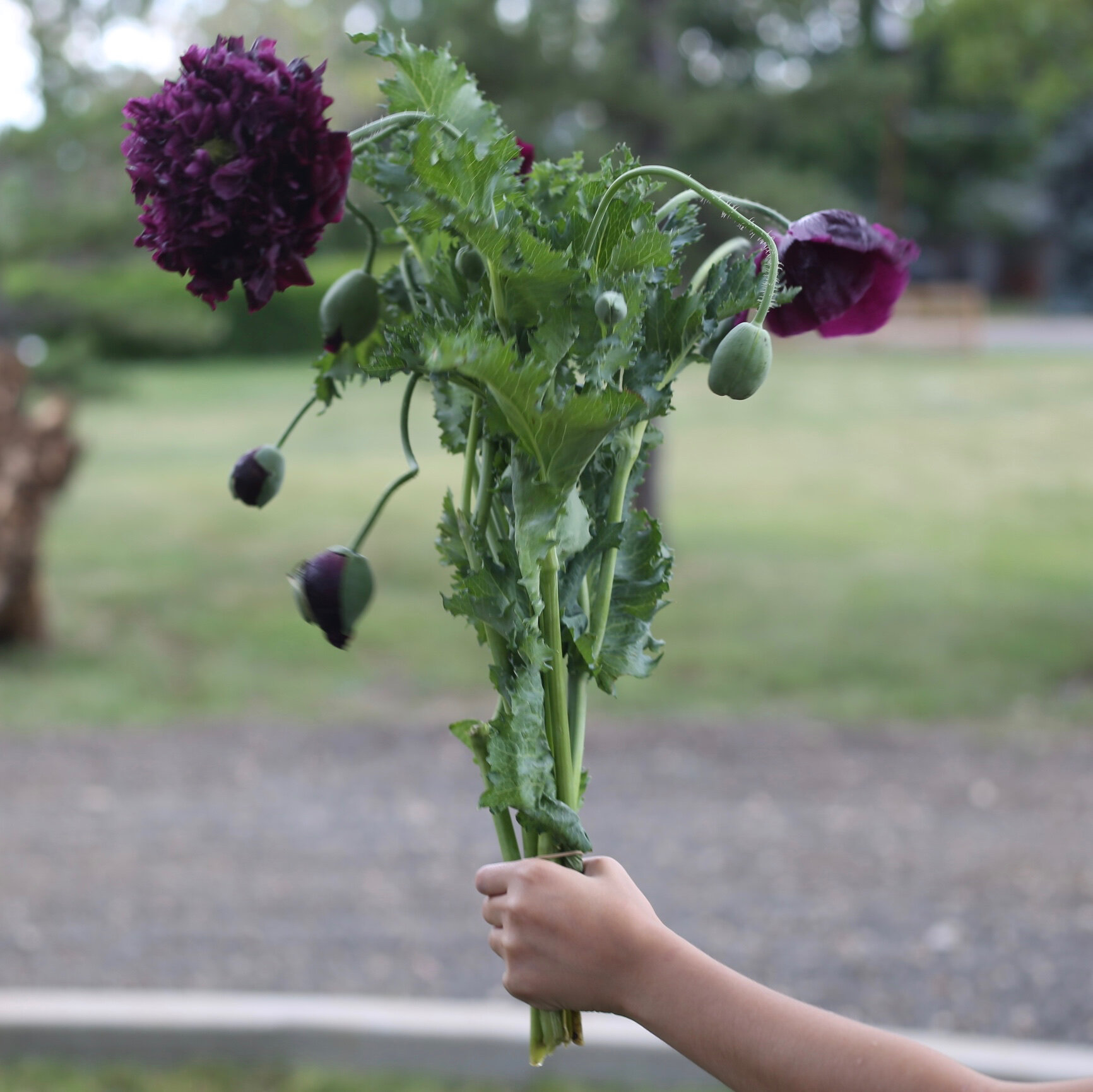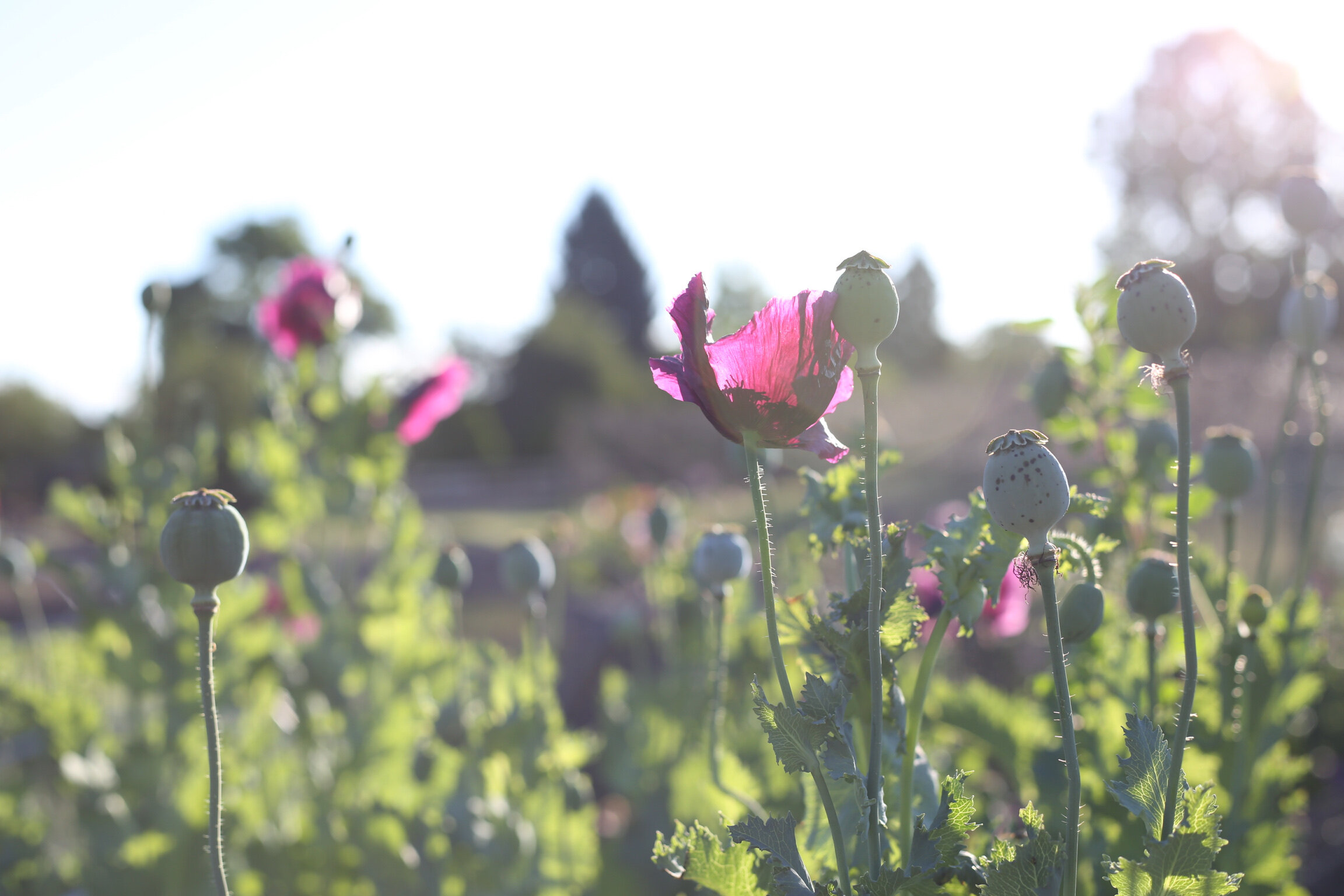Growing Poppies
Garden notes: Papaveraceae
This season I grew 3 different types of poppies: Breadseed Poppies, California Poppies, and Icelandic Poppies. The use of heat mats, humidity domes, and a magnifying glass had me feeling like I was back in science class. Some of the best farmers and gardeners I know have told me of their struggles with getting them to germinate and bloom. Their seeds are tiny and temperamental making planting them a challenge to start from seeds but once you crack the germination code you can begin experimenting with all different types of poppies, or you can order them as plugs from a wholesaler or buy plants at a nursery. This year as I experimented with three different species I learned how they grow differently and are used differently in floral design.
1. California Poppy (Eschscholzia californica), the ‘Thai Silk Series’ in Champagne
2. Bread Seed Poppies (Papaver spp.), the Black Beauty cultivar
3. Icelandic Poppies (Papaver nudicaule ),
California Poppies (on the left) are small wildflower poppies you see on hillsides in California or in many of the wildflower mixes in Colorado and other zone 5 areas. Most commonly seen are the bright orange cultivar but its a little too bright for design work so I tried the Thai Silk series. They bloomed in June and the color ranges from cream to blush tones and the petals really do look like silk. They are drought tolerant and rewarded me with many blooms. Most seed packets tell you to direct sow them in the garden in early spring but I transplanted them with success this year. They are much smaller than other species. They stand about 6-8” tall, have silky petals that open and close with the sun. Their dainty fern like leaves in blue/green hues were a hit among designers. There are many different varieties, this year I grew Thai Silk Champagne, which have a muted peach color tones. Their stems are shorter so they would only work for arrangements vs. tall market bouquets. While they are a cut and come again, once the heat of July set in they didn’t look great.
California Poppy
Thai Silk, Champagne
The second species I grew were Breadseed Poppies, Black Beauty variety. They had large drooping heads that don’t last long in a vase but they have interesting seed pods that last a very long time dried. I sold all of them quick and wish I had a lot more. Their growing habit is enormous compared to California Poppies, but unlike California Poppies, they are a one hit wonder meaning they have big blooms but they only bloom once. Once I cut them they are done and they don’t last long in a vase…maybe 2-3 days. I am growing them alongside of California poppies and the difference is extreme. The Breadseed poppies have big wide leaves, they stand about 4’ tall, and have large cupped flowers that look almost leathery. They don’t have a long vase life even after I seared the stems which typically works for Iceland Poppies. Perhaps they are more of a landscape poppy than a cut flower poppy. I found that their pods did open in water even if picked while they were fully closed.
Breadseed Poppy
Black Beauty
The third species I grew are Icelandic Poppies. They are tall, fragrant poppies commonly used in cut flower production for their 18” stems. Not only do they look great in arrangements but they hydrate well and can last up to a week in a vase. My favorite thing about them though is their soft fragrance that is so delicate and sweet. I have found that searing the end of the stems with a blow torch works really well and gets them to last a week in a vase. Their growth habit is in between a small California Poppy and a large Bread Seed Poppy. Their leaves tend to stay close to the ground while stems reach up 2’ above their leaves, and I don’t cut the leaves them for arrangements…just the flower.
Icelandic Poppy
Colibri
Will I grow these again?
It’s a hard call because I didn’t sell very many of them but I will definitely try to grow all of them again but in more strategic landscaped areas. I want to try the Icelandic Poppy, Colibri, next year and will order plugs from a wholesaler. I’ll plant them in the field. I’ll need to grow them either in a tunnel or hoop house to get them to bloom in early spring. I’d grow this variety production style because designers are seeking this out more than other varieties. I’ll only incorporate the Bread Seed and California poppy into our landscaped areas and not grow them as a production crop.
Would I recommend any of these poppies for the home gardener?
If they can find plants at a nursery. Once they get started they do reseed themselves when the conditions are right, and they will continue to bloom each year, but starting them from seed is tricky and not for most home gardeners. They add unique form to your garden with their long unusual stems, and big bright blooms during late spring/early summer just after tulips, peonies, and trees are done blooming and before summer flowers take off.
How to grow them?
There are some key steps you have to take when growing poppies from seed. They involve starting them early (Feb), in seed trays on a heat mat set to 78 degrees, and a humidity dome. Their seeds are extremely small and they like warm wet conditions to germinate. If you can’t grow them under these conditions, then don’t bother. You can look at your local nursery for poppy plants in early spring and then transplant them into your garden. It is hard to find unique varieties at big box stores so seek out plant nursery’s that specialize in rare varieties.
Please let me know if you learned something from this post. I’m just starting out on this platform and my goal is to help others gardeners in my zone (5-7) succeed. I’d love to hear your thoughts and feedback on if I’m on the right track.
Gina







